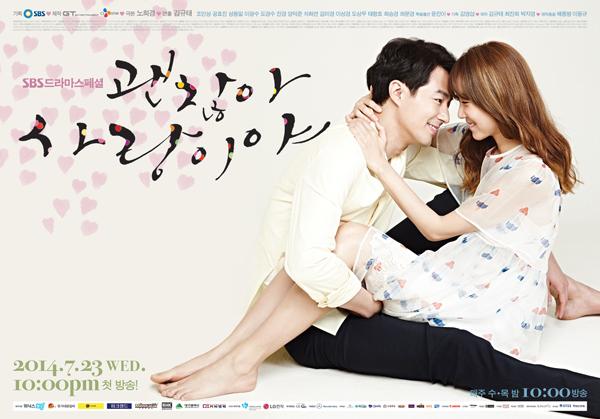A TV drama shatters taboos around mental health in South Korea
An advertisement for "It's OK, That's Love," a Korean TV show that aired this summer and became one of the country's few public forums discussing mental health.
South Korea is notorious for having one of the world’s highest suicide rates. The country has consistently fallen near the bottom of global happiness indices for years. Yet despite these glaring statistics, few, if any, South Koreans talk openly about mental health.
But that may be changing now thanks to a recent television drama that takes place in the mental health ward of a hospital.
The TV show, titled “It’s OK, That’s Love,” stars Gong Hyo-jin as psychiatrist Ji Hae-soo, who works at the hospital in Seoul. She meets a successful novelist struggling with obsessive-compulsive disorder and schizophrenia. What begins as a series of comedic encounters soon transforms into a budding romance between two people coming to grips with their own inner turmoil.
The program is already beginning to lift the veil — if only slightly — on long-held taboos around mental health.
Hong-gyun Yoon, a practicing psychiatrist in Seoul, says he’s seen an uptick in the number of visitors to his office seeking treatment since the show aired this summer. “Many of them want to know whether they suffer from OCD, like the main character in the show,” he explained. Most of these new patients are young people.
Data from the Korea Centers for Disease Control and Prevention show that some 13 percent of adults in South Korea reported feeling depressed for up to two consecutive weeks in 2012. The number of cases involving depression or other mental-health related conditions spiked 77 percent in the last decade, with more than half of those cases admitting to having thoughts of suicide.
“Before I watched this drama, I thought seeking help for things like depression was bad," wrote an anonymous Seoul resident on Naver, a huge Korean website.The user explained that he lost his job because of depression and asked for suggestions of hospitals that offer counseling.
Cultural taboos around mental illness also extend to Koreans living abroad, including in the United States.
Jonathan Kang, a clinical psychologist working with mostly Korean immigrants in Los Angeles, says many Korean Americans tend to delay treatment until well after first noticing signs of distress. That makes treatment more complicated. "It’s important they come in as soon as they detect warning signs," he says.
But while Korean TV dramas are also popular within Korean American immigrant communities, whether or not they can actually change behavior remains a question.
Eunice Kim, a Korean immigrant who works as medical interpreter in San Francisco, is an avid consumer of Korean dramas. She says these shows might have an impact on younger, more tech-savvy Korean Americans, but thinks older first-generation immigrants tend to be even “more conservative” than their peers in South Korea. That’s because many arrived prior to the explosion of the Internet and tend to be more isolated from public discussions around social issues.
Kim points to a popular 2010 Korean TV drama that featured a romantic relationship between two men. The show aired 10 years after Korean TV personality Seokcheon Hong came out publicly as gay. Initially met with derision and open hostility, he later landed a spot on a cable series where sex and sexual orientation are openly discussed.
But Kim says that while it sparked conversation in Korea, she saw “little change” in attitudes among first-generation Korean immigrants here.
When it comes to getting treated for mental health, South Koreans have more to worry about than public shame. A New York Times article from 2011 pointed out that those people who seek counseling often pay in cash so no records show when they seek employment.
Perhaps more trouble are people's fears of being hospitalized against their will. Korean law makes involuntary confinement relatively easy: The approval of one or both parental figures, along with a clinician’s diagnosis, is enough.
In one scene from the TV show, the lead male character is forcibly institutionalized at the urging of his mother, who fears that he is suicidal. It's the kind of scene that Yoon, the Seoul psychiatrist, says is a typical media portrayal of people with mental health issues, reinforcing the notion that such people need to be isolated from mainstream society.
“The way media portray people with mental health problems must change,” he says, adding that often such individuals are depicted as being the butt of jokes. Yoon says such stereotypes “make people want to hide their problems.” Mental health advocates in the country are now working to change the law on involuntary confinement.
But for Ji-eun Yang, a 22-year-old living in Ulsan, an industrial port city in the country’s southeast, the TV show made the thought of seeking treatment less intimidating when “my mind is hurt or wounded.”
Yang says the show also made her realize just how common mental health disorders can be, noting that one of the characters, a psychiatrist named Dong-min Cho, seeks help for emotional trauma after a bitter divorce. When his friend, a surgeon, laughingly points out the irony of a psychiatrist needing therapy, Cho replies, “Would it be OK to laugh at you for getting cancer, even if you’re a surgeon?”
The scene, Yang says, “showed me that people facing mental health struggles are not as far from me as I thought.”
Additional reporting by Peter Schurmann. This story was produced as part of New America Media's ongoing coverage of mental health issues among youth and immigrant communities. For more information, visit #FeelBetter.
Our coverage reaches millions each week, but only a small fraction of listeners contribute to sustain our program. We still need 224 more people to donate $100 or $10/monthly to unlock our $67,000 match. Will you help us get there today?
